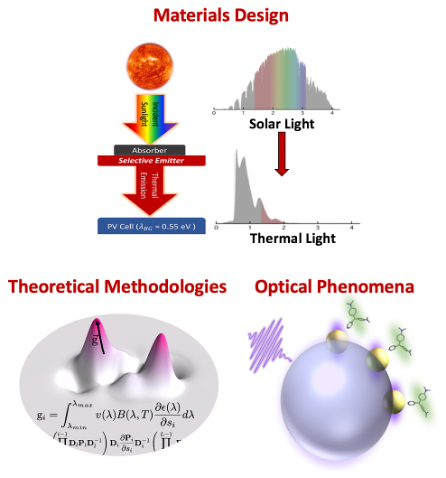Research Description
 Precise control over light-matter interactions opens opportunities to address many pressing questions in chemistry and materials sciences. How can we design materials that can harness heat for energy conversion and preservation? Can we use light from diffuse sources like the sun to steer chemical reactions towards desired outcomes? How do we accurately model molecules and light on equal quantum mechanical footing?
Precise control over light-matter interactions opens opportunities to address many pressing questions in chemistry and materials sciences. How can we design materials that can harness heat for energy conversion and preservation? Can we use light from diffuse sources like the sun to steer chemical reactions towards desired outcomes? How do we accurately model molecules and light on equal quantum mechanical footing?
Research in the Foley Lab leverages multi-scale theoretical and computational approaches to study fundamental aspects of light-matter interactions to address question such as these, and to enable the design of nanoscale materials and devices to realize related technologies. Key scientific outcomes of our group include elucidation of an emergent phenomenon in composite metal-dielectric nanoparticles known as “scattering mediated absorption”, the development an open-source software package, WPTherml, for designing materials for harnessing heat, the elucidation of the role of photonic dissipation in polaritonic chemistry, and the realization of spectrally selective thermal emitters made from robust materials with record-breaking performance for solar thermophotovoltaics alongside experimental collaborators. Our research has been supported by the American Chemical Society Petroleum Research Fund and is currently supported by the Research Corporation Cottrell Scholar Award, the NSF CAREER award in the Chemical Theories, Models, and Computational Methods program, and the Department of Energy through the Computational Chemical Science program. We welcome students and postdoctoral scholars with diverse sets of interests and with the desire to develop a variety of different skill sets. Members of the group may pursue projects studying the fundamental optical properties of nanomaterials, application of those materials and devices towards practical problems related to energy, development of software for the simulation and design of optical nanomaterials, or development of theoretical and computational methods aimed at elucidating the chemical physics of molecules strongly coupled to light. We endeavor to advance theory and computation in ways that add value to experimental work, so students desiring to undertake collaborative projects that bridge experiment and theory will also find ways to engage in our research.